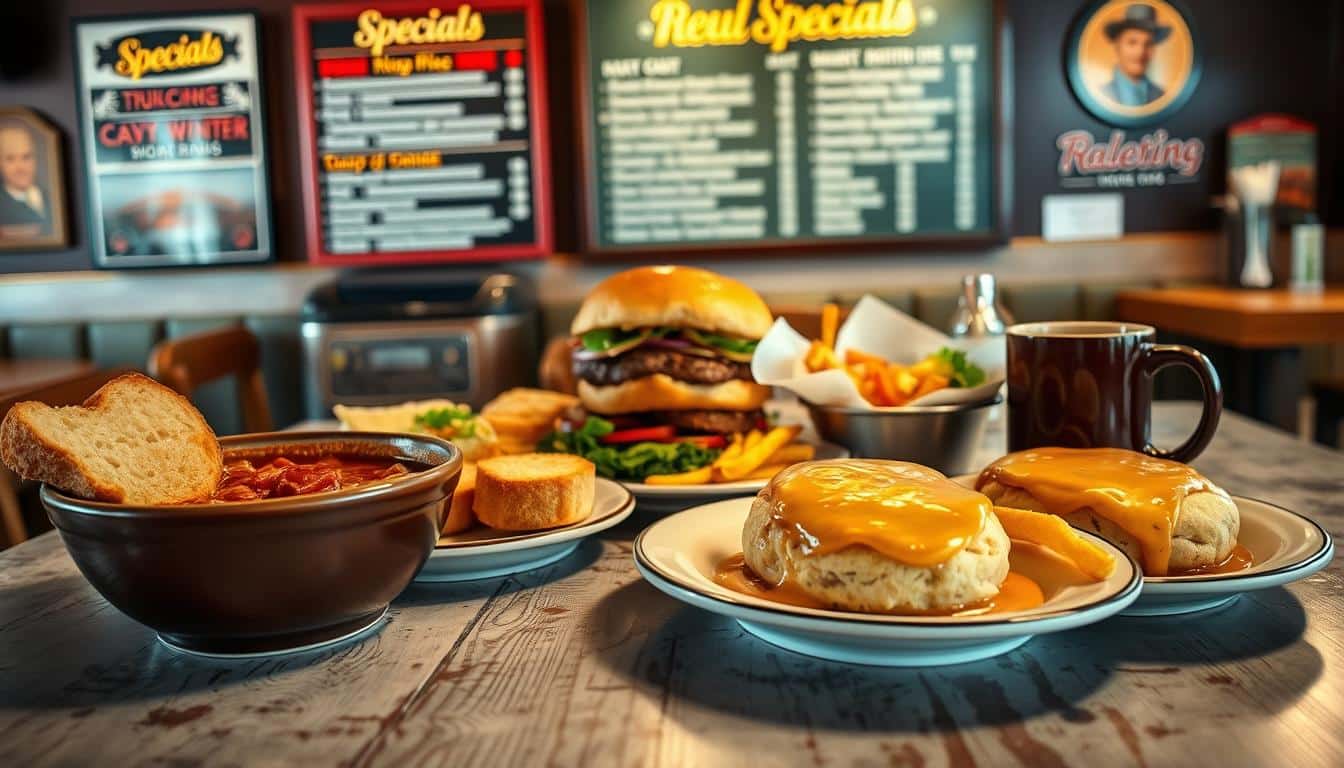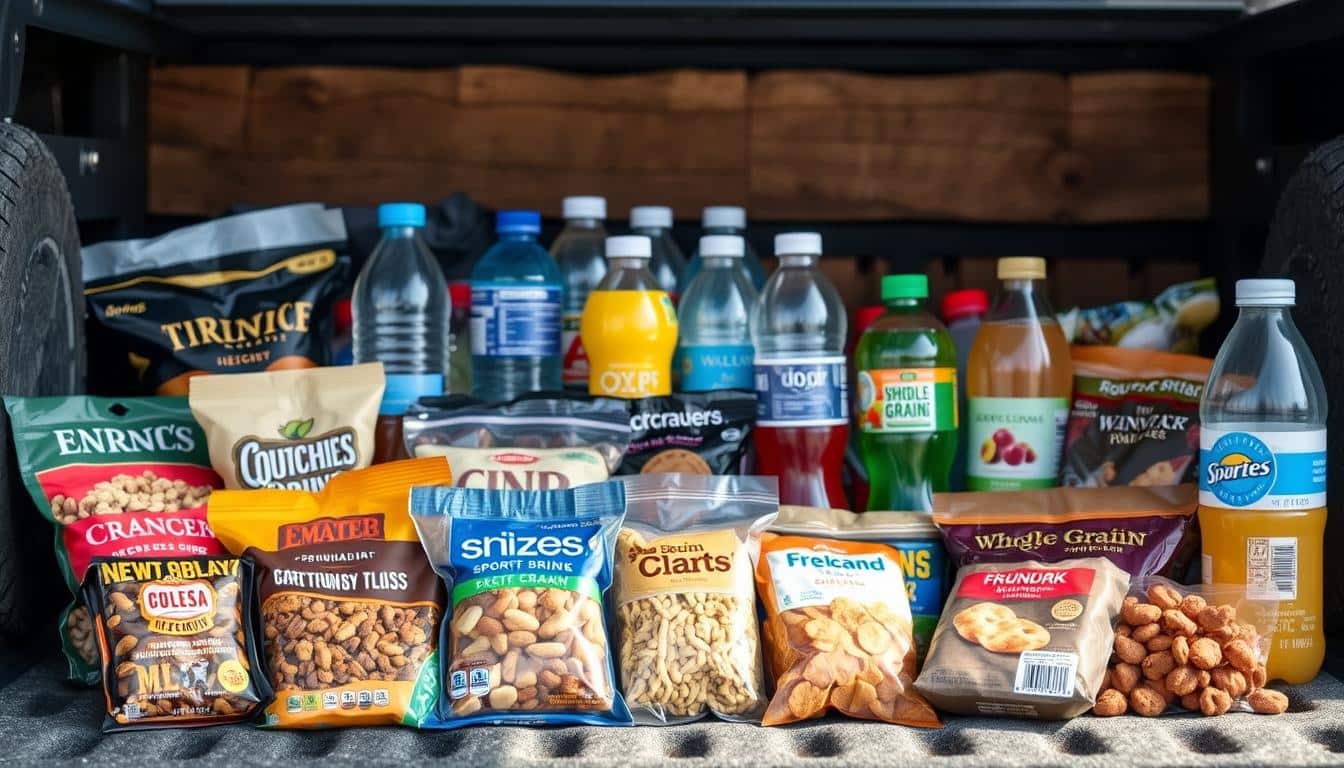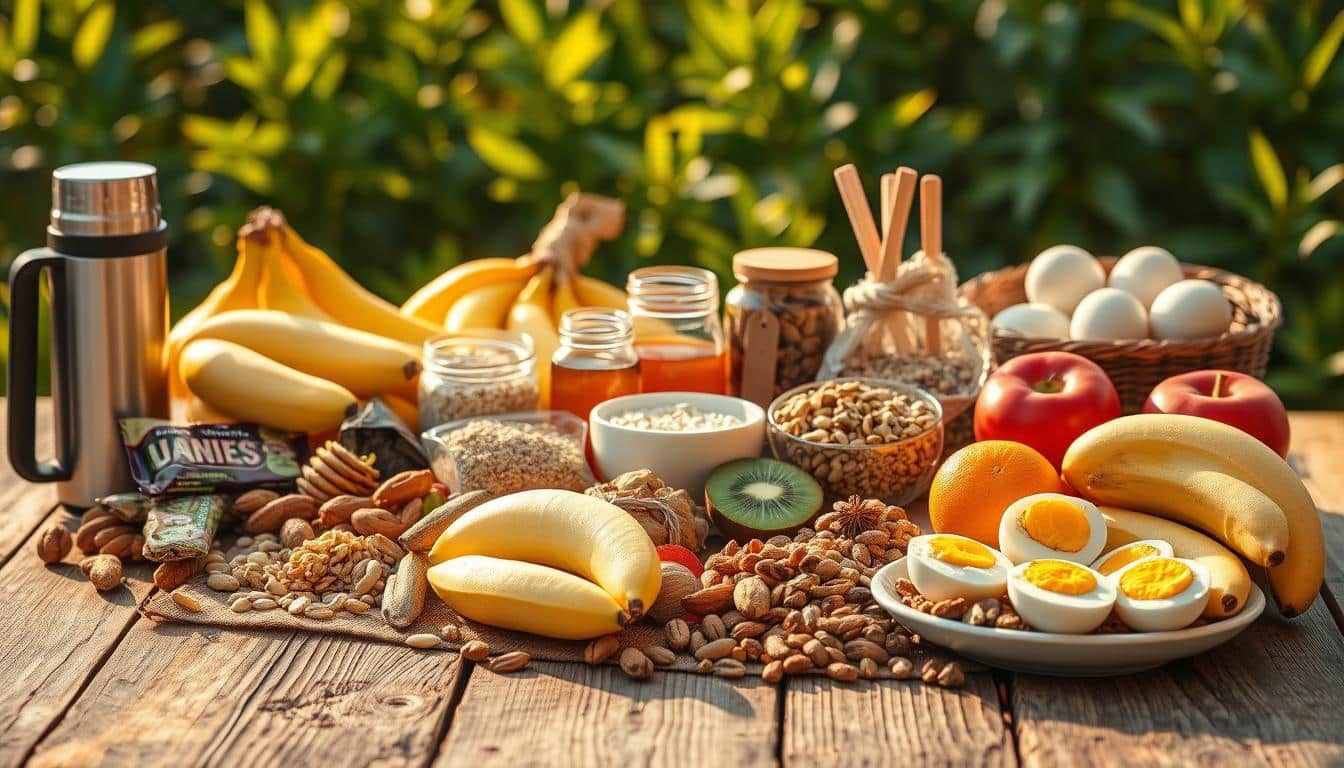Life on the road changes sleep, schedules, and meal choices. HMD Trucking and the Bureau of Labor Statistics show truck drivers burn about 1,975 calories daily. At the same time, CDC data reveals many face diet-related health issues. This highlights the need for smart meal choices to stay alert and healthy.
Simple changes and a bit of planning can lead to healthier meals without needing fancy equipment. With things like a cooler, mini-fridge, or a 12-volt lunchbox cooker, you can keep Greek yogurt, boiled eggs, and grilled chicken ready. Road Legends and the Truck Driver Institute suggest preparing portions, varying meals, and starting simple to avoid fast food.
High-protein meals should mix protein, fiber, and healthy fats. This blend helps control hunger and supports muscle and focus. Try egg-based breakfasts, bean salads, beef jerky, and protein bowls. These choices, along with watching portion sizes and sugar intake, can lower health risks.
This guide gives proven meal ideas and tips for using appliances safely, reading labels, and packing food. Begin with one high-protein meal or snack daily and go from there. Even small changes can make a big difference on long trips.
Why protein matters for truck drivers’ health and performance
Long hours of driving need smart food choices for safety and health. Truck drivers have unique hurdles: little space to cook, many stops, and lots of unhealthy snacks. Knowing the basics helps them pick meals for better energy and focus.
Truckers burn more calories than you might think. The government says they use about 1,975 kcal a day just driving. But eating too much junk food can add extra calories they don’t need.
- Use a BMR calculator to find out how many calories you should eat.
- HMD Trucking says to aim for under 2,000 kcal daily if you’re not working out.
- Road Legends tells drivers to prep meals themselves to cut down on fat, calories, and salt.
How much protein truck drivers need depends on their activity level and size. Generally, adults should get 46–56 grams of protein a day. Those who exercise more might need extra protein.
Eating protein helps you feel full longer, stopping you from snacking on junk food. Foods like eggs, Greek yogurt, beans, or lean meats are great for keeping you full. Plus, they help you avoid eating too much at pit stops and control your weight.
Drivers should also think about muscle upkeep. Adequate protein is key for recovering after exercise and keeping muscles strong. This helps with safely getting in and out of the truck, handling cargo, and staying mobile in the long run.
Eating badly can lead to common trucker health issues. Too much salt from fast food can raise blood pressure. Too many calories and sitting too much can lead to gaining too much weight; a problem the CDC says is common among drivers. These issues can make drivers more likely to get heart disease or diabetes.
- Choose lean proteins for meals to avoid high-calorie snacks.
- Control portions to get the right amount of protein without extra calories.
- Keep meals interesting and healthy with simple cooking tools and low-salt recipes.
Making smart changes can have a big impact. Bringing along hard-boiled eggs, canned tuna, or Greek yogurt can cut down on bad eating habits. Eating the right amount of protein helps drivers stay focused, remain healthy, and cut down on health risks in the future.
protein-packed meals for truckers
Long drives require meals that keep you alert and ward off hunger. Aim for 20–35 grams of protein per main meal, with fiber and some healthy fats. This helps you avoid fast food and makes meal prep simpler for busy trips.
Defining a protein-packed meal for long-haul drivers
For a meal rich in protein, include eggs, chicken, tuna, Greek yogurt, or beans. Also add whole grains or root veggies, plus colorful fruits or veggies. HMD Trucking says these meals fight obesity and disease. They also help with muscle strength and focus while driving.
Examples of balanced protein meals that travel well
There are many types of protein meals that are good for the road. Road Legends suggest changing them up to avoid boredom and eat well.
- Egg-based trucker meals: hard-boiled eggs, egg muffins, or portable omelet cups paired with whole-grain toast and cherry tomatoes.
- Lean meats and salads: rotisserie chicken or turkey breast in jar salads with quinoa, greens, and a simple vinaigrette.
- Legumes and grain bowls: black beans or lentils with brown rice, salsa, and avocado for a high-fiber, protein-forward bowl.
- Greek yogurt snacks: single-serve Greek yogurt with nuts and berries for a quick, protein-rich pick-me-up.
Portion guidance to avoid overeating while meeting protein goals
Truckers can manage portions by using containers that fit protein needs. The Truck Driver Institute recommends single-serve packs and portioning snacks and meats to avoid eating too much.
- Measure protein: aim for 20–35 grams per meal and 10–15 grams per snack.
- Pack portions: store meals like cooked chicken, tuna, or eggs in containers for single servings.
- Start small: make one or two meals ahead to fit your schedule and storage space.
Top high-protein breakfast ideas for the cab
Long journeys need nourishing breakfasts that power focus and curb hunger. Truckers can craft quick, tasty meals perfect for the road and small spaces. Check out these tips from HMD Trucking, Road Legends, and Truck Driver Institute for easy prep, storage, and keeping things interesting.
-
Egg-based options
Hard-boiled eggs are great for mornings. They last well in a mini-fridge, offering fast protein that’s easy to eat on the move.
Make omelets with veggies and turkey sausage using a portable skillet. Or prep egg bakes in a loaf pan for the week. They’re easy to reheat and carry.
-
Greek yogurt bowls and smoothies
Greek yogurt bowls are a protein-packed choice. Mix them with fruit, nuts, and oats. They fit well in a mini-fridge.
Mix milk, Greek yogurt, fruit, and protein powder for smoothies. Use a portable blender to whip up this creamy treat anywhere.
-
High-protein muffins and bars
Oat, nut, banana, and protein powder muffins are perfect for busy days. Drivers can bake, freeze, and then thaw them as needed.
Energy and oat bars are convenient. Road Legends says they’re great with coffee or for an energy boost while driving.
-
Grab-and-go protein choices
If cooking’s not an option, try mixed nuts, jerky, and single-serve nut packs. Perfect for quick energy with no fuss.
Choose protein bars with low sugar for long trips. Pairing a bar with a boiled egg or Greek yogurt makes a complete, easy meal.
Rotate a variety of options to keep breakfast interesting. Start with small amounts, keep them cool, and mix up your choices. This keeps breakfast simple yet healthy and driver-friendly.
Hearty protein lunch and bowl recipes for the road
Lunch on the go needs to be simple, fridge-friendly, and high in protein. It helps you stay energized. Combining basic elements allows for various meals throughout a busy week. Include fruits and vegetables to make meals complete and skip the greasy options at rest stops.
Choose grains that stay fresh. Quinoa and brown rice are great for both hot and cold dishes. When you want something different, try whole-grain or legume pasta.
- Quinoa or brown rice + grilled chicken, black beans, roasted peppers, and a squeeze of lime.
- Legume pasta + baked tofu, spinach, cherry tomatoes, and low-sodium vinaigrette.
- Brown rice + turkey burger crumbles, steamed broccoli, and a light yogurt dressing.
For salads that last, try jar salads and protein packs. These keep everything fresh. Start with the dressing, then add hardy veggies, and finish with protein and greens. They’re perfect for a quick, nutritious lunch straight from the fridge.
- Layered jar: dressing, chickpeas, cucumbers, carrots, grilled chicken, greens.
- Lunch protein packs: sliced deli turkey, cheese cubes, almonds, and apple slices.
- Cottage cheese or Greek yogurt cups with a side nut mix for extra protein.
Wraps and sandwiches are also good for traveling. Pick whole-grain or lettuce over regular bread to stay healthy. Keep sauces separate so your meal doesn’t get mushy.
- Turkey wraps on the road: whole-grain tortilla, lean turkey, avocado, spinach, and mustard packed separately.
- Lettuce wraps: turkey burger slices, shredded carrot, cucumber ribbons, and a small hummus tub.
- Simple sandwich: whole-grain bread, roasted chicken, baby spinach, and a thin slice of Swiss cheese.
Make several meals at once to keep things interesting. The Truck Driver Institute recommends keeping extras on the side. They say black beans and grilled chicken are dependable proteins. Use a fridge or cooler to keep meals safe. HMD Trucking suggests picking turkey burgers, beans, and chicken soup for good meals. They say to eat less cheese and fried foods. Road Legends likes quick salads and protein bowls for busy truckers.
Each cooler should have several lunch protein packs for the week. These packs help you save time and keep your meals regular. Changing up dressings or proteins can refresh your meals without much work.
Protein-rich snack strategies to avoid truck-stop junk food
Long trips make it hard to resist junk food. Smart snacks help maintain energy and avoid late-night junk food runs. Truck drivers should pack various snacks, some that don’t need refrigeration and some that do.
Start by making a snack bag for easy access. Choosing the right snack and its amount is key. Having a few good options helps with hunger and keeps blood sugar level.
-
Portable protein snacks: Beef jerky, almonds, hard-boiled eggs, and cheese sticks are great on the go. It’s best to choose beef jerky with less sugar and salt for a healthier choice.
-
Pre-portion snacks: Small bags or containers are perfect for trail mix, carrots, and mixtures of nuts and seeds. Road Legends and HMD Trucking suggest pre-portioning to avoid eating too much.
-
Protein packs: Try turkey, cheese, and nuts for a quick snack. Truck Driver Institute recommends almonds and hummus as easy snacks.
Choose healthier options at truck stops. Go for Greek yogurt, unsweetened popcorn, or trail mix instead of candy or soda. This helps avoid extra calories with no extra work.
-
Single-serve cottage cheese or hummus with veggies or crackers is a good choice.
-
Choose dried fruit without added sugar over candy. Mixed nuts are a better choice for a lasting full feeling.
-
Pick beef jerky or turkey sticks with clear ingredients and less salt.
Change your snacks weekly to keep things interesting. Drink water and cut back on sugary drinks to stay sharp and avoid tiredness in the afternoon. Small steps like having snacks ready and choosing healthier options make a big difference.
Easy protein dinners using small appliances in the rig
Long drives need dinners that are easy, filling, and easy on the stomach. Small appliances help make meals rich in protein that stay warm, reduce preparation time, and work with limited electricity. Try using a slow cooker, lunchbox cooker, portable skillet, or a sturdy thermos to keep food delicious and safe while traveling.
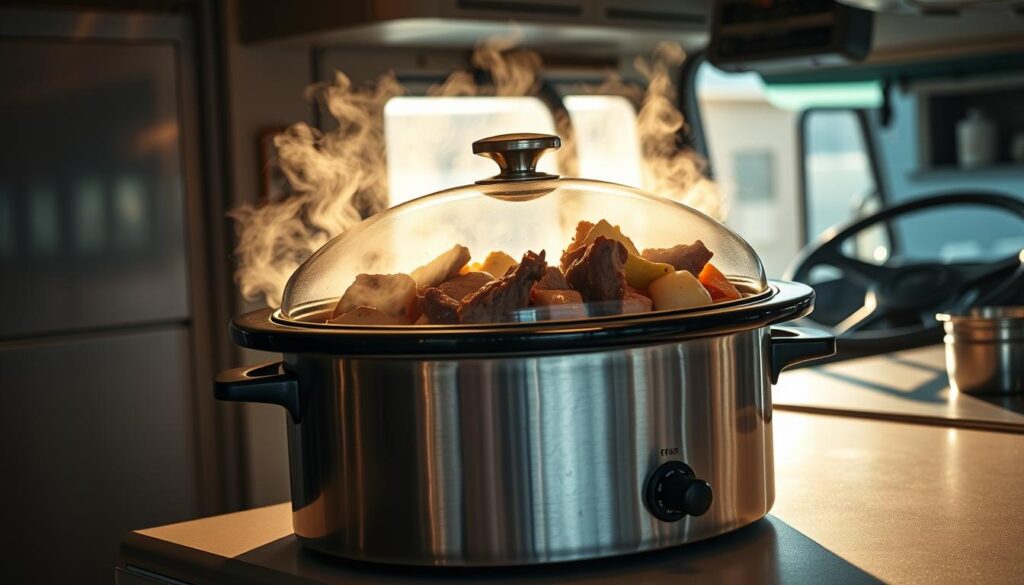
Slow cookers and lunchbox cookers are great for meals that cook by themselves. Just add lean pork, chicken, or turkey with some low-sodium broth and vegetables into the slow cooker. You get a protein-rich dinner without effort. Lunchbox cookers are ideal for making egg dishes and casseroles that are easy to heat and then cool down safely when you turn the power off.
- Try pulled chicken with black beans and salsa for easy portioning.
- Make beef stew with carrots and potatoes for a hearty cab meal.
- Keep sauces separate to avoid sogginess and to control sodium at serving time.
Portable skillets allow drivers to make quick, hot meals without needing a full kitchen. You can make stir-fries and quesadillas that combine lean meats, shrimp, or tofu with veggies and low-sodium sauces for a healthy meal. Meals made in a trucker skillet can be reheated easily and help avoid unhealthy food stops.
- Stir-fry sliced chicken, snap peas, and peppers in a dash of low-sodium soy for a quick protein boost.
- Make whole-wheat quesadillas with shredded turkey, black beans, and a sprinkle of cheddar for a handheld dinner.
Thermoses and cold nights go well with make-ahead soups and stews. Cook big portions at home or in a truck setup that’s safe, then put them into insulated containers. Truckers who bring a hot thermos can enjoy a warm, protein-filled meal without having to turn appliances back on during a rest.
- Chili with lean beef or turkey is great for freezing and reheats well in a thermos.
- Vegetable-and-lentil stews have both fiber and protein and leave you feeling full for longer.
It’s important to plan for power needs. Make sure your inverter’s wattage matches your appliances to prevent electrical problems. Set timers, pre-portion your meals, and always cool, refrigerate when parked, and heat foods to the right temperature before eating.
These tips for using portable cookers and ideas for slow cooker dinners in the rig make meal times both efficient and healthy. With just a few changes in how meals are prepared and the appliances used, truckers can enjoy better food. This way, they don’t have to give up taste or time while on the road.
Meal prep tips and storage for long trips
Planning ahead is key to eating well on the road. Truck drivers who plan can keep food fresh, save money, and skip unhealthy truck-stop food. Here are steps to set up a good food system in your truck.
How to stock a mini-fridge and cooler for freshness
Begin with a small mini-fridge and a soft cooler for extra space. Fill them with long-lasting foods like Greek yogurt, hard-boiled eggs, cooked chicken, hummus, and cut fruit. Use containers that stack and have clear tops to see inside easily.
Put dates on your meals. Move older items up front so you use them first. When using a cooler, choose ice packs over loose ice to avoid leaks.
Using an inverter safely for small appliances
Always test your appliances before your trip. Make sure your inverter can handle them and stay within safety limits for your truck. Be careful with devices like microwaves and blenders that use a lot of power.
Pick an inverter that stops overload. Use a strong power strip that fits your truck’s power. And have a wattage guide handy in a cabinet for quick checks.
Batch cooking, rotating menus, and starting small with weekly prep
Batch cooking is a big time saver for truck drivers. Cook a lot of one dish, like shredded chicken, and split it into servings. Freeze some and keep some in the fridge.
Change your menu every week to keep things interesting. Try using three main recipes and change the sides or sauces. If you’re new to this, start by preparing just a couple of meals your first weekend.
- Portion control: pre-measure to match BMR-based calorie targets.
- Thermos use: keep soups and stews hot for hours without reheating.
- Grocery runs: plan stops near major hubs to restock fresh items.
By sticking to these habits, you’ll always have delicious and healthy meals ready. This will help you stay focused and energized on long trips.
Low-prep, no-reheat protein options for unpredictable schedules
When you’re on the go, you need meals that are simple and quick. Foods that taste good cold and can be eaten fast are best. They help you stay awake and ready for the journey ahead.
For a trucker’s kitchen, cold proteins are key. Canned tuna, precooked chicken, hummus, and cottage cheese are great. They’re easy, need no cooking, and give you good protein. Pair them with things like crackers, veggies, or greens for a complete meal.
- Choose canned tuna or salmon for long shelf life and easy portions.
- Pick up rotisserie chicken on the road for ready-made salads and wraps.
- Grab hummus tubs and cottage cheese for creamy protein that needs no heat.
Eating ready-to-go foods can save you time and reduce trash. Favorites include turkey, cheese, and nuts packed together. These snacks are nutritious, satisfying, and easy to eat on the move. Other good choices are nuts with seeds, fruits with cheese, and salads in a jar.
- Mix a protein pack with apple slices for fiber and flavor.
- Combine nut mixes with dried fruit for quick energy on long legs.
- Use jar salads topped with rotisserie chicken on the road for a full meal.
Keeping meals cold is crucial for your health and to prevent food from going bad. You can use mini-fridges, cool bags, and ice packs. Make sure to change the ice packs every day. Keep uncooked foods away from those you can eat straight away. Also, store dairy and meats correctly.
Some handy tips can improve your eating habits. Divide food into portions to avoid eating too much. Choose foods with less salt. And drink plenty of water to stay hydrated. Try water first before sugary drinks.
Without the ability to heat food, no-cook protein options and smart food storage are vital. They give you the energy you need, cut down on stops, and help you keep eating healthy on the road.
Budget-friendly high-protein shopping and packing tips
Truckers can keep protein high and costs low to stay fueled on the road. Buying in bulk and packing meals can help you save money and eat healthier. Avoiding truck-stop food becomes easier with a little planning and some smart shopping.
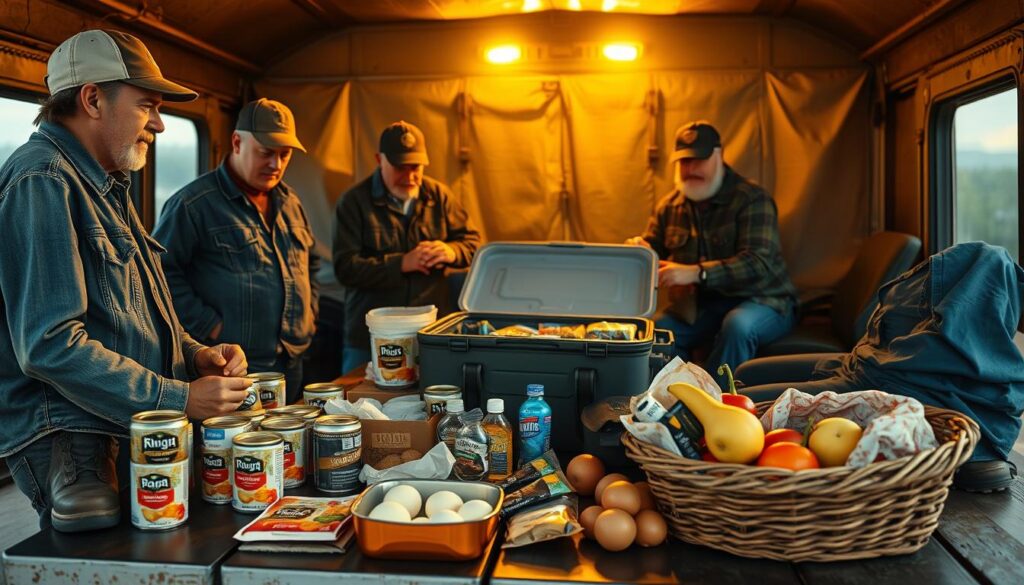
Choosing affordable, high-protein foods gives you more bang for your buck. Opt for eggs, canned tuna, salmon, beans, Greek yogurt, and bulk nuts. A rotisserie chicken can make several meals and is easy on your wallet. These items are perfect for on-the-go eating, whether cold or warmed up.
- Buy eggs and Greek yogurt for quick breakfasts and snacks.
- Stock canned fish and beans for sandwiches, salads, and bowls.
- Purchase bulk nuts and oats to DIY trail mix and protein-packed breakfasts.
Try to plan your grocery shopping around your trucking route and schedule. Look for stores with better prices near major trucking hubs. Creating a shopping list with versatile items can help you make meals for the week. Portioning food at home helps avoid waste and impulse buys.
- Map grocery stops along your regular route before you leave.
- Buy staples in bulk and split into single-serve packs at home.
- Rotate proteins so meals feel fresh and you avoid repetition fatigue.
Packing meals smartly can save both time and money. Store salads and proteins in airtight containers to keep them fresh. Using one or two frozen meals as ice packs at the start of your trip is a great trick. Then, you can enjoy them later once they’ve thawed.
Always be mindful of nutrition facts when picking up packaged foods. Choose items with low sodium and not much sugar. Protein bars and ready-made meals can be high in calories and salt without you realizing it. Reading labels carefully can help you avoid food that’s bad for your health and your budget.
- Target products with less than 500 mg of sodium per serving when you can.
- Pick bars with no more than 10 grams of added sugar and clear protein information.
- Avoid processed meats with lots of ingredients and high sodium.
For truckers on a budget, mix wholesale purchases with the occasional fresh find. Turn leftovers into new meals, like using beans in salads or tuna on rice. These strategies help you stay fed, save money, and skip expensive food stops.
When you’re short on time, rely on no-cook items from your last grocery run. Keeping a small, varied stock cuts down on waste and lessens the temptation for pricey road food. Smart shopping tactics help truckers keep their diet and spending on track.
Managing sodium, sugar, and calories while maximizing protein
Eating enough protein without adding too much salt, sugar, or calories is smart for drivers. Look at food labels. Plan easy swaps. This helps control blood pressure, avoids insulin spikes, and sticks to calorie goals.
Identifying high-sodium processed protein items to avoid
- Be careful with deli meats, canned soups, and many jerky brands. HMD Trucking says they’re often high in sodium which raises blood pressure.
- Pick canned fish in water, not brine. Choose Greek yogurt with no salt for keeping in the cab.
- When dining out, ask for sauces on the side. Choose grilled proteins over cured or smoked to cut down on sodium.
Reducing added sugars and choosing low-sugar protein bars and drinks
- Go for protein bars and drinks with less sugar to reduce empty calories and diabetes risk. Truck Driver Institute likes plain Greek yogurt and sugar-free options.
- Look for syrups, cane sugar, and maltodextrin on labels. Road Legends suggests energy bars with under 6–8 grams of added sugar.
- Make snacks ahead of time and have low-sugar protein bars ready for easy, healthy snacks on the go.
Using BMR and portion control to keep daily calories in check
- Start with a BMR calculator for baseline needs. Many drivers start with about 2000 kcal, adjusting for their activity level.
- Break down calories into meals and snacks for balanced protein all day. This helps stay full and control calories.
- For portion control, use small containers and weigh your food when you can. Logging meals helps control sodium, sugar, and calories while hitting protein targets (aim for 46–56 g/day, more or less depending on size and activity).
Practical swaps and tracking help a lot. Choose low-sodium proteins and low-sugar bars. Use BMR to manage portions. This keeps your energy up while driving.
Practical meal and snack schedules to maintain energy and focus
Eating at regular times keeps drivers alert during long trips. Have small, protein-packed meals and snacks every 3–4 hours. This helps you stay energetic, less hungry, and focused while driving.
Timing meals around driving shifts to prevent drowsiness
Eat a balanced meal at least two hours before sleeping. HMD Trucking says to skip heavy meals before sleep for better rest. If you need to eat close to driving time, pick small portions to prevent sleepiness.
Combining protein with fiber and healthy fats for sustained energy
Combine lean proteins with veggies, grains, beans, nuts, or avocado for long-lasting energy. Road Legends and the Truck Driver Institute suggest this mix for prolonged fullness and stable blood sugar. For a strong protein and fiber boost, try egg-and-vegetable salad, tuna with whole-grain crackers, or Greek yogurt with berries and almonds.
Hydration’s role: water, low-sugar drinks, and avoiding excess coffee/soda
Truckers should drink water and low-sugar drinks to stay sharp. Sip small amounts often, instead of drinking a lot at once. Cut back on soda and caffeine; too much coffee can ruin sleep and make you crash later. Proper hydration aids in digestion, focus, and staying awake at the wheel.
On the road, remember these tips: pack snacks, always have water handy, and remember your meal schedule. Small tweaks in your routine and food choices can make long drives better and safer.
Conclusion
Eating healthy is doable for truckers if they plan ahead and use the right tools. HMD Trucking suggests focusing on portion sizes, bringing your own meals, figuring out your basic metabolic rate (BMR), and drinking plenty of water. This strategy helps avoid health issues like obesity and high blood pressure. It also makes packing protein-rich foods easier and more consistent.
Starting with small steps is key, according to Road Legends and the Truck Driver Institute. They recommend using a mini-fridge, an inverter, or a crockpot. It’s also good to pre-portion snacks and try new recipes often. Focusing on foods like eggs, Greek yogurt, canned tuna, beans, and nuts not only saves money but provides steady energy. Changing up meals helps you stick to your plan and avoid unhealthy fast food.
It’s smart to plan when you’ll eat based on your driving schedule. Combine protein with fiber and healthy fats to keep your energy levels even. Regular meal prep that includes easy-to-make protein dishes can improve focus and muscle health. Small dietary changes lead to better driving and reduce the risk of long-term illnesses.
FAQ
What is a protein-packed meal for long-haul truck drivers?
How many calories and how much protein does an average truck driver need?
Why is protein important for truck drivers’ alertness and health?
What are simple high-protein breakfasts I can make in the cab?
Which protein-packed lunches or bowls work best on the road?
What are portable snack ideas that beat truck-stop junk food?
How can I prepare protein dinners using small in-rig appliances?
What no-reheat, low-prep protein options are safe for unpredictable schedules?
How do I stock a mini-fridge and cooler efficiently for long trips?
What appliances can I safely run in a truck and what should I check first?
How can I cut sodium and added sugars while keeping protein high?
How should I portion meals and snacks to avoid overeating on the road?
Can meal prepping save money and time for drivers?
What are quick swaps to make truck-stop choices healthier?
How should I time meals to maintain alertness during driving shifts?
What inexpensive proteins offer the best value for the road?
How much protein should I aim for per meal to meet daily needs?
Are protein bars a good option for drivers?
What practical steps help me start meal prepping for a week on the road?
Content created with the help of Artificial Intelligence.

